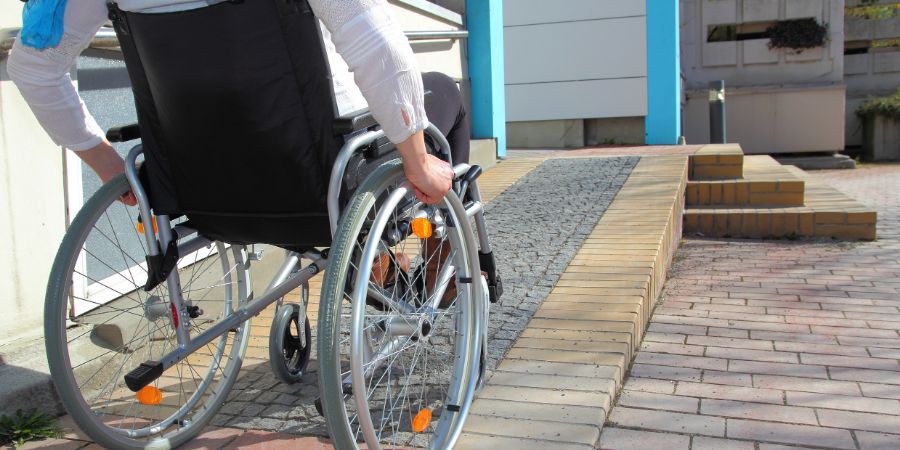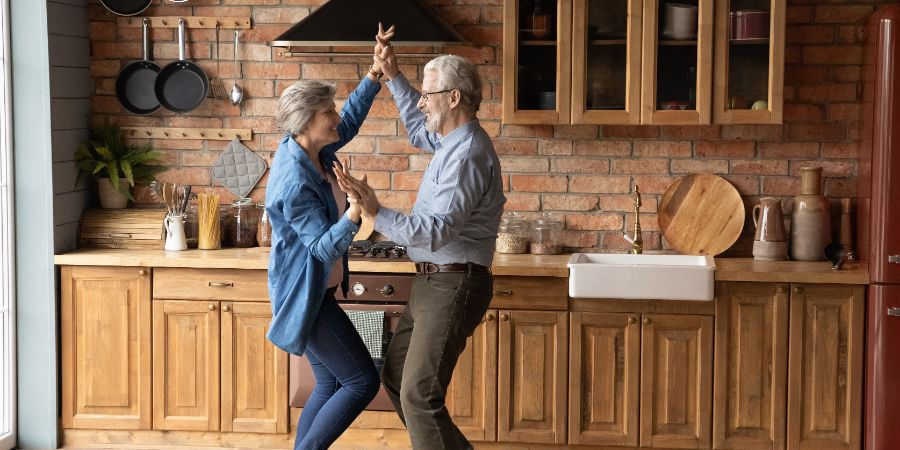Aging in Place design is a term that’s becoming more and more popular each year. It refers to the ability of seniors to live in their own homes for as long as possible, regardless of age or ability. This can be done through modifications made to the home, or by choosing furniture and accessories that are safe and easy to use.
In this article, we’ll discuss what Aging in Place design is, as well as provide top tips to help you safely assist clients in EVERY room of their home!
First Thing’s First: What is Aging in Place Design?
Aging in Place design is all about making modifications to the home that will allow seniors to live safely and independently. As an Aging in Place designer, your job will be to inspect the client’s home and then come up with a list of recommendations for changes that need to be made. These changes can include anything from installing grab bars in the shower to widening doorways to accommodate wheelchairs.
It’s important to note that not all seniors will need or want the same modifications. For this reason, it’s important to work closely with your clients to determine their specific needs.
From there, once you’ve got a good understanding of what your client is looking for, you can help them start making some changes!
If you’re interested in learning more about what Aging in Place design entails, this article‘s got everything you need to know!
Aging in Place: Home Design Tips For EVERY Room
As we mentioned before, Aging in Place design is all about making modifications to the home that will allow seniors to live safely and independently. But what does that look like, exactly?
In this section, we’ll provide some top tips for Aging in Place design in EVERY room of the home!
Living Room
One of the most important things to consider in the living room is lighting. Make sure there are plenty of light sources, and that they’re easy to reach. Your client might also want to consider installing a dimmer switch, which can be helpful for seniors with vision impairments.
Another important thing to keep in mind is furniture placement. Seniors should be able to easily get in and out of chairs and sofas, so make sure there’s plenty of space around them. You might recommend to your client that they also consider getting rid of any coffee tables or end tables that could be tripping hazards.
Lastly, make sure there are no loose rugs or cords that could cause someone to trip and fall.
For more advice specific to living rooms for seniors, we recommend these 6 tips, courtesy of Companions For Seniors!
Bedrooms
In bedrooms, one of the most important things to consider is the bed. It’s important to make sure that seniors can easily get in and out of bed, so you might recommend a raised platform or an adjustable bed.
You’ll also want to make sure there’s plenty of space around the bed for seniors to move freely. Seniors with vision impairments might also want to consider installing a nightlight.
In the closet, be sure to recommend that seniors store items they don’t use often on higher shelves, and items they use more frequently on lower shelves. This will make it easier for them to reach everything they need.
Interested in learning more about design tips for seniors’ bedrooms? Livspace has 5 tips that are sure to help you out!

Bathrooms
The bathroom is one of the most important rooms to consider when it comes to Aging in Place design. There are a few things you’ll want to keep in mind, like installing grab bars near the toilet and in the shower or tub. You might also want to suggest raised toilets and walk-in showers.
It’s also important to make sure there’s plenty of lighting in the bathroom, as well as non-slip flooring. These modifications will help prevent seniors from falling and injuring themselves.
You can learn even more about bathroom design tips for seniors in this helpful blog article by Sebring.
Kitchen
In the kitchen, one of the most important things to consider is the layout. Seniors should be able to easily reach everything they need, so you might suggest making some changes to the way the cabinets and appliances are arranged. You might also want to install a pull-out cutting board or a pot filler above the stove.
Another thing to keep in mind is lighting. Make sure there are plenty of light sources, and that they’re easy to reach. You might also want to consider installing a dimmer switch. Lastly, as we’ve mentioned before, be sure to recommend non-slip flooring, as this will help prevent seniors from falling and injuring themselves.
If you’re in need of some inspiration, Houzz offers 10 awesome tips for kitchen designs with seniors in mind!
Entryway
In the entryway, one of the most important things to consider is lighting. Make sure there are plenty of light sources, and that they’re easy to reach. You might also want to consider installing a motion sensor light.
Another thing to keep in mind is storage. Seniors should have a place to store their belongings when they come in the door, so be sure to recommend some sort of storage solution, like a coat rack or a bench with built-in storage.
You might also want to suggest installing a ramp or removing any potential trip hazards, like loose rugs or cords.
For more entryway design tips for seniors, we recommend checking out this guide by AIP Contractor!
Garage
In the garage, one of the most important things to consider – again – is lighting. Your client will want to make sure there are plenty of light sources, and that they’re easy to reach. You might also want to recommend that they install a motion sensor light.
Another thing to keep in mind is storage. Seniors should have a place to store their belongings when they come in the door, so be sure to recommend some sort of storage solution, like shelves or hooks. You might also want to suggest installing a ramp or removing any potential trip hazards, like loose rugs or cords.
Here are some wonderful recommendations for carports and garage ideas for Aging in Place design that we definitely suggest checking out!
Outdoor Living Spaces
When it comes to outdoor living spaces (be it the front yard or the backyard), one of the most important things to consider is accessibility. If your client has a pool, they’ll want to make sure there’s a way for seniors to safely get in and out. The same goes for any hot tubs or spas.
Speaking of accessibility, if your client has difficulty walking (especially if they require the aid of a walker or wheelchair), they’ll want to make sure there’s a smooth, level path leading up to their front door. You might also want to suggest installing a ramp or removing any potential trip hazards, like loose rugs or cords.
In the backyard, you’ll want to recommend some sort of seating solution – preferably one that’s comfortable and easy to get in and out of. You might also want to suggest installing a pergola or gazebo, as this will provide some much-needed shade on those hot summer days.
For more outdoor living space design tips for seniors, check out these wicked tips by The Deck Store!

Frequently Asked Questions
Next, let’s answer some frequently asked questions about Aging in Place design!
Q: What is meant by Aging in Place?
A: Aging in Place is the ability to live in one’s own home and community safely, independently, and comfortably, regardless of age, income, or ability level.
Q: What are some common features of an Aging in Place home?
A: Some common features of an Aging in Place home include wider doorways and hallways, lever door handles, grab bars in the bathroom, and non-slip flooring.
Q: Who is an Aging in Place Designer?
A: An Aging in Place Designer is a professional who specializes in making expert recommendations for designing homes for seniors that are safe, comfortable, and easy to navigate.
Q: What is the most common Aging in Place remodeling project?
A: The most common Aging in Place remodeling project is widening doorways and hallways.
Q: Why do people prefer to age in place?
A: There are many reasons why people prefer to age in place. Some of the most common reasons include wanting to stay in their own home, being close to family and friends, and having a sense of independence.
Q: What are some common challenges of aging in place?
A: Some common challenges of aging in place include difficulty with mobility, chronic illness, and cognitive decline.
Q: What are the disadvantages of aging in place?
A: Some of the disadvantages of aging in place include isolation, loneliness, and depression.
Q: How can Aging in Place design help combat these disadvantages?
A: Aging in Place design can help combat these disadvantages by making expert recommendations for designing homes that are safe, comfortable, and easy to navigate. This can help seniors feel more independent and connected to their community.
Q: Is Aging in Place design only applicable to seniors?
A: No, Aging in Place design is not only applicable to seniors. It can also be applied to people of all ages who have difficulty with mobility, chronic illness, or cognitive decline.

How To Become an Aging in Place Designer
If you’re interested in becoming an Aging in Place Designer, there are a few things you should know! First and foremost, you’ll need to have a strong interest in design and a passion for helping seniors. It’ll also help if you have some sort of prior experience working with clients who have difficulty with mobility, chronic illness, or cognitive decline (although this isn’t mandatory).
In addition to these qualifications, you’ll need to be proficient in CAD software. This is because some projects might require you to create detailed drawings and floorplans of the homes you’re working within. We also recommend possessing a strong understanding of building codes and regulations, since you’ll need to ensure that your designs and/or modification suggestions meet all applicable code requirements.
It’s also worth noting that in order to succeed as an Aging in Place designer, you’ll need to be able to effectively communicate with clients and contractors. This is because a lot of the work you’ll be doing will involve coordinating with other professionals to ensure that your designs are executed properly.
Will You Need To Be Certified?
Now that you know a little bit more about what it takes to become an Aging in Place Designer, you might be wondering if you’ll need to be certified in order to practice. The answer to this question varies from state to state/place to place. In some states, there is no certification required in order to work as an Aging in Place Designer.
However, in other states (like Florida), certification is required in order to practice.
Now, if you live somewhere that doesn’t require certification training, does that mean you have a free pass to skip out on it? Sure – but chances are, you won’t find much success out in the real world.
The reality is, most clients are going to want to work with an Aging in Place designer who has some sort of professional certification. After all, being certified shows that you have the skills and knowledge necessary to properly assist them in designing their home. It also helps give them peace of mind knowing that they’re working with someone who is an expert in the field.
So, while you technically don’t need to be certified in order to practice Aging in Place design in some places, we highly recommend seeking out certification training all the same. Not only will it make you a more competitive candidate when vying for clients, but it’ll also help you to better serve those who do choose to work with you!
QC Design School’s Aging In Place Course
If you’re interested in becoming certified in Aging in Place design, QC Design School offers a comprehensive self-paced, online course that covers everything you need to know! This course is perfect for those who are just starting out in the field, as well as those who have some experience but are looking to brush up on their skills.
Here’s what you’ll learn in each unit:
Unit A
- The role and responsibilities of an AIP designer
- Common psychological changes, medical conditions, and lifestyle changes your clients may be experiencing
- Various housing and support options available
- How to act as an Aging in Place educator
- How to market your AIP services successfully
Unit B
- Developing the skills needed to properly assess clients’ needs
- How to evaluate homes from an Aging in Place perspective
- How to create Aging in Place modification plans
- AIP design standards and principles (and how to apply them)
- Incorporating decluttering and home transition services into your Aging in Place design business
Unit C
- Final project of the course
- Will require you to with the home of a known friend or relative
- You will use everything you’ve learned to assess that person’s home, as if it belonged to an Aging in Place client
- From there, you’ll conduct a mock needs assessment, create a customized design plan, and explain all of your reasoning behind every decision made
The beauty of QC’s Aging in Place Course is that it’s 100% online and self-paced. Although you’ll be given two full years to finish your program (starting from the day you enroll), YOU get to decide how much of that two-year timeframe you’ll actually need. Many grads have found that they were able to complete their course in as little as 3-6 months – simply by devoting a mere 1-2 hours per week to their studies.
And the best part?
Once you’ve graduated, QC Design School will mail you your globally-recognized Aging in Place Professional (APDP) certification! This also acts as your official designation/title… Meaning, you can proudly add it to your resume, business cards, website, social media profiles, and all marketing materials for your business!
Here’s the full Aging in Place Course curriculum so you can learn more!

Conclusion
Aging in Place design is a rapidly-growing field, and one that is expected to continue growing in popularity as the Baby Boomer generation continues to age. With the tips provided in this article, we hope you’ll have a better idea of how to apply AIP design to every room of your clients’ homes.
And if you’re interested in getting involved in this industry? We highly recommend seeking out professional certification training. Not only will it make you a more competitive candidate when vying for clients; it’ll also help you to better serve those who do choose to work with you!
Got any questions or comments about this article? Please share them below – we love hearing from you!
Thanks for reading!


